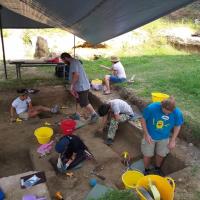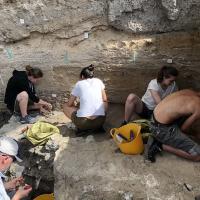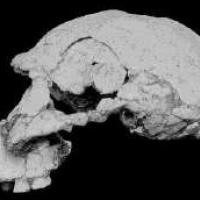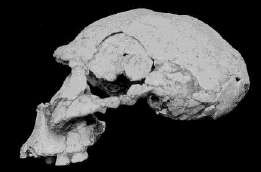Latest News






|
|
Gabunia et. al. published a paper Earliest Pleistocene Hominid Cranial Remains from Dmanisi, Republic of Georgia: Taxonomy, Geological Setting, and Age in Science, saying that the new fossils, two hominin crania, uncoverd in the excavation season 1999 in Dmanisi are comparable with the Homo ergaster from Koobi Fora and are dated to 1.7 million years ago indicate on first migrations out of Africa.
Abstract
 Archaeological excavations at the site of Dmanisi in the Republic of Georgia have uncovered two partial early Pleistocene hominid crania. The new fossils consist of a relatively complete cranium and a second relatively complete calvaria from the same site and stratigraphic unit that yielded a hominid mandible in 1991. In contrast with the uncertain taxonomic affinity of the mandible, the new fossils are comparable in size and morphology with Homo ergaster from Koobi Fora, Kenya. Paleontological, archaeological, geochronological, and paleomagnetic data from Dmanisi all indicate an earliest Pleistocene age of about 1.7 million years ago, supporting correlation of the new specimens with the Koobi Fora fossils. The Dmanisi fossils, in contrast with Pleistocene hominids from Western Europe and Eastern Asia, show clear African affinity and may represent the species that first migrated out of Africa.
Archaeological excavations at the site of Dmanisi in the Republic of Georgia have uncovered two partial early Pleistocene hominid crania. The new fossils consist of a relatively complete cranium and a second relatively complete calvaria from the same site and stratigraphic unit that yielded a hominid mandible in 1991. In contrast with the uncertain taxonomic affinity of the mandible, the new fossils are comparable in size and morphology with Homo ergaster from Koobi Fora, Kenya. Paleontological, archaeological, geochronological, and paleomagnetic data from Dmanisi all indicate an earliest Pleistocene age of about 1.7 million years ago, supporting correlation of the new specimens with the Koobi Fora fossils. The Dmanisi fossils, in contrast with Pleistocene hominids from Western Europe and Eastern Asia, show clear African affinity and may represent the species that first migrated out of Africa.
